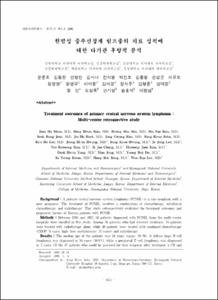KUMEL Repository
1. Journal Papers (연구논문)
1. School of Medicine (의과대학)
Dept. of Internal Medicine (내과학)
원발성 중추신경계 림프종의 치료 성적에 대한 다기관 후향적 분석
- Alternative Author(s)
- Do, Young Rok; Kwon, Ki Young; Song, Hong Suk
- Journal Title
- 대한내과학회지
- ISSN
- 1738-9364
- Issued Date
- 2006
- Abstract
- Background : A primary central nervous system lymphoma (PCNSL) is a rare neoplasm with a
poor prognosis. The treatment of PCNSL involves a combination of chemotherapy, intrathecal
chemotherapy and radiotherapy. This study retrospectively evaluated the treatment outcomes and
prognostic factors of Korean patients with PCNSL.
Methods : Between 1995 and 2003, 58 patients diagnosed with PCNSL from the multi-center
hospitals were enrolled in this study. Among 56 patients who had received treatment, 16 patients
were treated with radiotherapy alone, while 40 patients were treated with combined chemotherapy
(CHOP; 9 cases, high-dose methotrexate; 31 cases) and radiotherapy.
Results : The median age of the patients was 58 years (range, 19-76). A diffuse large B-cell
lymphoma was diagnosed in 56 cases (96.6%), while a peripheral T-cell lymphoma was diagnosed
in 2 cases. Of the 47 patients who could be assessed for their response after treatment, a CR and PR was observed in 32 (68%) and 11 patients (23%), respectively, giving an overall response rate
of 91% (95% CI, 82~100%). The estimated 3-year overall survival rate for all the patients was 67±
7.9% and the 3-year disease free survival rate was 53±8.3%. The overall survival of the high-dose
methotrexate group was superior to that of the CHOP group (77±10% versus 47±19%, p=0.05).
Leukoencephalopathy was observed as a late complication in 9 patients (21%). No significant
prognostic factors affecting survival were found by univariate analysis.
Conclusions : Approximately half of the patients could have long-term survival after treatment
in this study. High-dose methotrexate containing chemotherapy followed by radiotherapy was found
to be an effective treatment.(Korean J Med 71:654-661, 2006)
Key Words : Lymphoma, Central Nervous System, CHOP, High-dose methotrexate, Radiotherapy
목적 : 원발성 중추신경계 림프종은 그 발생빈도가
드물며 불량한 예후를 보이는 림프종의 아형으로, 치료
에는 항암화학요법, 척수강내 항암화학요법제 투여 및
방사선요법 등을 이용한 복합요법이 많이 이용되고 있
다. 본 연구는 다기관 후향적 분석을 통해 원발성 중추
신경계 림프종의 치료성적 및 그 예후인자를 분석하고
자 고안되었으며 기존의 CHOP 항암화학요법과 고용량
의 methotrexate 항암화학요법 간의 치료성적을 비교하
였다.
방법 : 1995년부터 2003년까지 경북대학교병원, 계명
대학교병원, 전남대학교병원 및 경상대학교병원에서 원발성 중추신경계 림프종으로 진단받은 58명의 환자가
포함되었다. 항암치료를 받은 56명의 환자 중 16명은 방
사선요법 단일요법을 40명은 항암화학요법(CHOP 9명,
고용량 methotrexate 항암요법 31명) 및 방사선요법을
받았다.
결과 : 대상 환자 중 남자가 31명(53%)이고 여자가
27명(47%)이었으며 나이는 19세에서 79세(중앙나이; 58
세)까지였다. 조직 소견상 미만성 거대 B-세포형 림프종
이 56예 말초 T-세포형 림프종 2예이었다. 치료 후 반응
평가가 가능하였던 47명에서 완전관해 32명(68%), 부분
관해 11명(23%)으로 전체반응율은 91%였다. 전체환자
의 3년 생존율은 67±7.9%, 3년 무병생존율은 53±8.3%
였으며, 고용량 methotrexate 항암화학요법군에서 3년
생존율 77±10% 및 3년 무병생존율 64±10%과 CHOP
항암화학요법군에서 3년 생존율 47±19%와 3년 무병생
존율 31±18%의 성적을 보여 두 군간의 전체생존율은
고용량 methotrexate 항암화학요법군에서 유의한 생존
율 향상을 보였다(p=0.05). 치료와 연관된 중추신경계의
합병증은 9명(21%)에서 백질뇌병증이 관찰되었다. 예후
인자 분석에서 의미있는 예후인자는 확인되지 않았다.
결론 : 원발성 중추신경계 림프종은 항암화학요법 및
방사선요법으로 50% 이상의 환자에서 장기생존이 가능
할 것으로 생각되며 항암화학요법으로는 고용량의
methotrexate가 효과적인 치료였다.
중심 단어 : 원발성 중추신경계 림프종, 항암화학요
법, CHOP, 고용량 methotrexate, 방사
선요법
- Alternative Title
- Treatment outcomes of primary central nervous system lymphoma :
Multi-center retrospective study
- Department
- Dept. of Internal Medicine (내과학)
- Publisher
- School of Medicine
- Citation
- 문준호 et al. (2006). 원발성 중추신경계 림프종의 치료 성적에 대한 다기관 후향적 분석. 대한내과학회지, 71(6), 654–661.
- Type
- Article
- ISSN
- 1738-9364
- Appears in Collections:
- 1. School of Medicine (의과대학) > Dept. of Internal Medicine (내과학)
- 파일 목록
-
-
Download
 oak-bbb-00662.pdf
기타 데이터 / 277.87 kB / Adobe PDF
oak-bbb-00662.pdf
기타 데이터 / 277.87 kB / Adobe PDF
-
Items in Repository are protected by copyright, with all rights reserved, unless otherwise indicated.